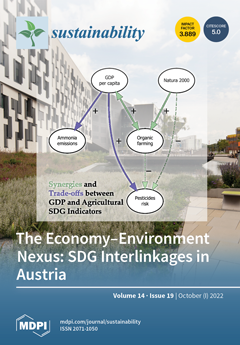“Ecological conservation and high-quality development of the Yellow River Basin” is one of the fundamental national strategies related to national food security and ecological security in China. Evaluating the impact of land use/cover change (LUCC) on soil erosion is valuable to improving regional ecological environments and sustainable development. This study focused on the Yellow River Basin and used remote sensing data, the soil wind erosion modulus (SWEM) calculated with the revised wind erosion equation (RWEQ), to analyze the impact of regional scale LUCC from 1990 to 2018 on soil wind erosion. The main conclusions are as follows: (1) The total area of cultivated land, grass land, and unused land decreased, with a total reduction of 11,038.86 km²; total areas of forest land and built-up areas increased, increased by 2746.61 and 8356.77 km
2, respectively, with differences within the region in these LUCC trends at different periods. From 1990 to 2000, the area of cultivated land increased by 1958.36 km
2 and built-up land area increased by 1331.90 km
2. The areas of forestland, grass land, water area, and unused land decreased. From 2000 to 2010, the area of cultivated land and grass land decreased by 4553.77 and 2351.39 km², respectively, whereas the areas of forestland and built-up land significantly increased. From 2010 to 2018, the area of cultivated land and grass land continued to decrease, and the area of built-up land continued to increase. (2) Since the 1990s, the SWEM has generally declined (
Slope1990–2018 = −0.38 t/(ha·a)). Total amount of wind erosion in 2018 decreased by more than 50% compared with the amount in 1990. During this period, the intensity of wind erosion first increased and then decreased. In terms of the SWEM, 90.63% of the study area showed a decrease. (3) From 1990 to 2018, LUCC reduced the total amount of soil wind erosion by 15.57 million tons. From 1990 to 2000, the conversion of grass land/forest land to cultivated land and the expansion of desert resulted in a significant increase in soil wind erosion. From 2000 to 2018, the amount of soil wind erosion decreased at a rate of about 1.22 million tons/year, and the total amount of soil wind erosion decreased by 17.8921 million tons. During this period, the contribution rate of ecological programs (e.g., conversion of cultivated land to forest land and grass land, ecological engineering construction projects, etc.) to reduction of regional soil wind erosion was 59.13%, indicating that ecological programs have a positive role in reducing soil wind erosion intensity. The sustainable development of the ecological environment of the Yellow River Basin should be continued through strengthening ecological restoration and protection, to further consolidate gains made in this fragile ecosystem. This study provides scientific and technological support and relevant policy recommendations for the sustainable development of the Yellow River ecosystem under global change.
Full article





